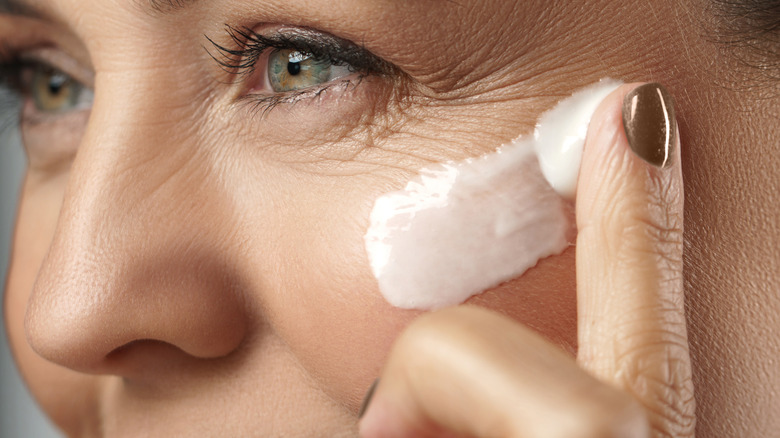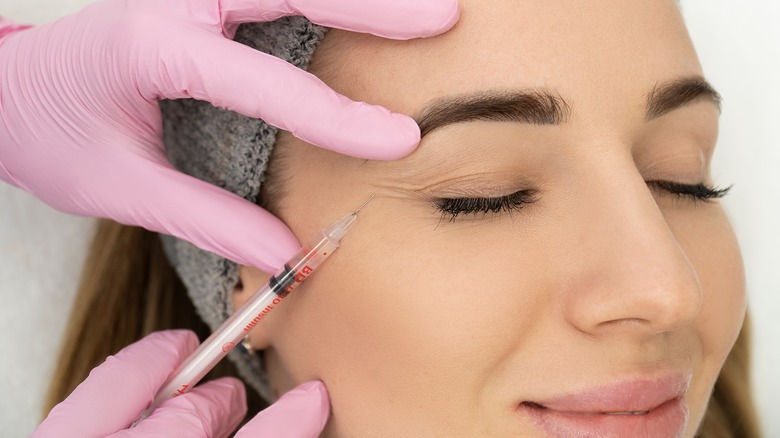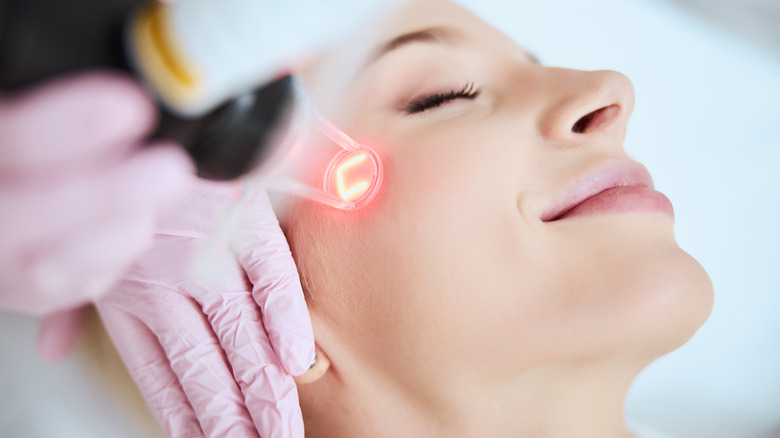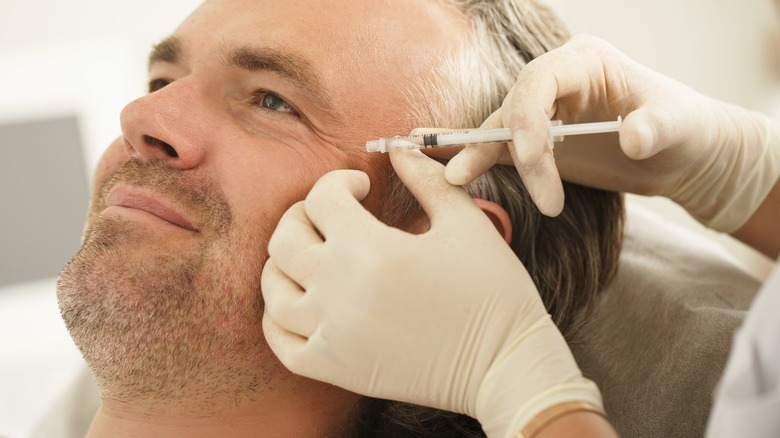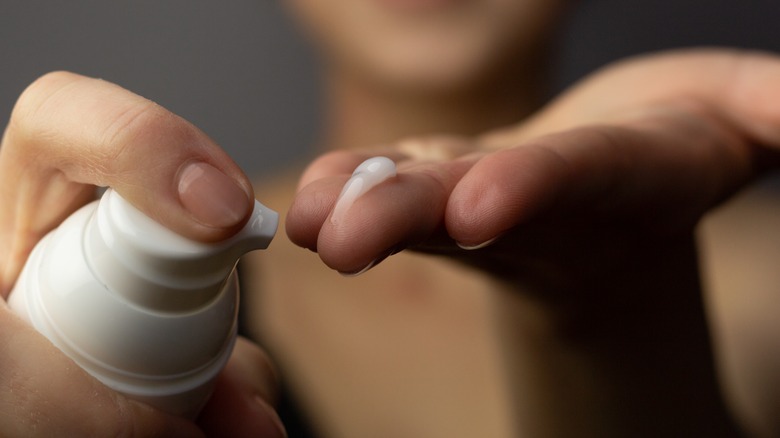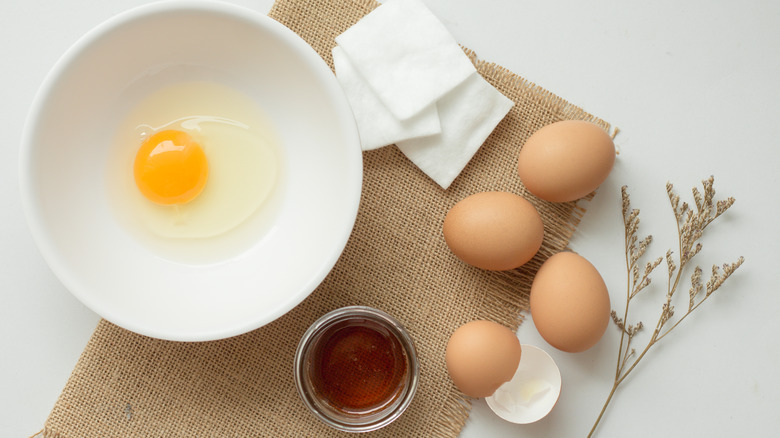The Best Ways To Treat Crow's Feet Around Your Eyes
There's no shame in rocking crow's feet around your eyes, especially since they're usually the result of constantly smiling! But there's also no shame in wanting to diminish them either. Crow's feet are those little lines that form around our eyes as a result of the muscles that tighten due to various displayed emotions. Other reasons these wrinkles may form include our dietary habits, genetics, and the dangerous lack of daily sunscreen usage. It's normal to start catching a glimpse of them once you reach your 30s, but a good skincare regimen may push that from happening until your 40s.
However, it can be difficult to pinpoint exactly which products and methods will work best. So, we've curated a list of different techniques we believe you'll find useful. From various types of skin creams to treatments, you're sure to find something that will satisfy both your skin type and budget. If you're ready to get started on your journey towards less noticeable crow's feet, take a look at all the information we've gathered below.
Botox
First on the list is botox: A useful procedure that can help diminish even the deepest of wrinkles. If you're not familiar with this treatment, Botox is a "purified form of botulinum toxin type A, which can be injected into the skin to reduce the visibility of facial lines and wrinkles," described by ProMD Health. Once it enters the skin, it will ease your tense muscles and simultaneously smooth out the surface of your face. Additionally, anyone in the age range of 25 to 65 years old can benefit from its skin-smoothing capabilities.
When this treatment is used on crow's feet, it is usually injected around the corners of the eyes. However, depending on the consultation with your practitioner, they may advise injecting botox in additional areas based on how deep and wide your wrinkles are. This procedure is typically 15 to 30 minutes long, and patients should expect their skin to appear slightly red and swollen once it's done.
Chemical peel
This may sound a bit extreme, but chemical peels are also an effective treatment in regard to crow's feet. It does so by "using a chemical solution to remove the outer layer of old skin," says the American Society for Dermatologic Surgery. The new layer that grows back is typically much smoother, and the appearance of wrinkles is less apparent. According to WebMD, those with a lighter skin complexion are typically better suited for this treatment because those with darker skin are more prone to producing an "uneven skin tone."
However, regardless of your skin tone, ASDS recommends speaking to a dermatologist first before making any decisions. While speaking with your healthcare provider, discuss your desired results, and they will provide you with a few options. Additionally, it's important to note that after a chemical peel, patients must avoid sun exposure for a few months. If this is something you're unable to do, you may be better suited for a different type of procedure.
Laser treatment
According to Lumiere Pure Body Med Spa, laser therapy — specifically the fractional CO2 laser — can help permanently diminish the appearance of crow's feet. This is an especially great alternative for those who are afraid of needles but want Botox! It works by warming up the inner layers of your skin to produce more collagen. This is important because collagen is a protein capable of strengthening your skin and growing new skin cells. A few signs indicating low collagen levels are the appearance of more wrinkles and hollow eyes.
Depending on the type of issues you're tackling, this type of treatment can take anywhere between 30 minutes to two hours to complete. Patients are typically given some anesthesia to help deal with the pain and an ice pack afterward to minimize swelling. However, the one major downside to this treatment would definitely be the cost. Patients have reported paying anywhere between $2,750 to $6,100, according to Healthline.
Dermal fillers
A treatment that's been hot on the market for the past few years is dermal fillers. This treatment is also known as soft-tissue filler and can be used to reduce the appearance of crow's feet. Additionally, there are a few options you can choose from, such as Juvederm, Radiesse, Restylane, Sculptra, and Belotero. Each option slightly differs in permanency, so it's important to rely on your doctor to choose the right option best suited for your skin.
Similar to botox, a needle is used to inject dermal fillers into your crow's feet. Depending on the option you choose, you could notice its effects anywhere from three to 12 months. And although it may be a bit more affordable than laser treatments, patients should expect to pay anywhere between $1,175 to $3,600, depending on location, your practitioner's qualifications, how many syringes are used, and a plethora of other factors (via RealSelf).
A cream worth trying
There are thousands of eye creams available claiming they're the ultimate cure for crow's feet. However, dermatologists favor one cream above them all: retinoids and retinol. They are a derivative of vitamin A, which is an ingredient known for diminishing the appearance of wrinkles. In fact, some medical professionals only trust this product. "I never recommend any of the other expensive products out there claiming to do this," Dermatologist Maryann Mikhail of Spring Street Dermatology in NYC told LiveAbout.
Some patients have complained of adverse side effects, such as redness and peeling. But it's essential to make sure you're using it right. A standard recommendation would be to start with a mild version (depending on your skin's sensitivity). Be sure to only use a pea-sized amount once a week for about a month before moving up to a few times a week. This way, you can build up a tolerance to avoid harsh reactions.
Natural treatments
If you're more comfortable with natural treatments, you can try making an egg-white face mask. Egg whites contain magnesium which is excellent for purifying your skin and smoothening it out. In order to create this mask at home, you'll need to mix an egg until it's become foamy. Then, carefully apply the first coat to your face. Once it has dried, you can slather on a second coat. After 15 minutes, simply wash off the face mask with a cleanser. This treatment can be repeated a few times a week.
Another common crow's feet-treating ingredient is aloe vera. It's full of vitamins A, C, E, and B12, making it a healthy choice for your skin! Slice open an aloe vera leaf before scooping out some of the gel. Then, dab a bit of it around your eyes and other problem areas before going to bed. Be sure not to rinse it off until the next morning.
